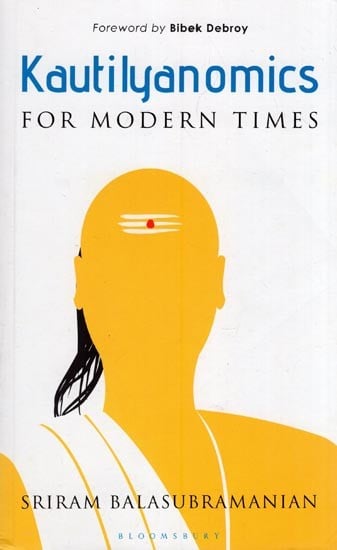- Skip to main content
-
-
Fri, Dec 02, 2022

Foreword: The book has been forwarded by Shri Bibek Debroy who is an Indian economist, serving as the chairman of the Economist Advisory Council to the Prime Minister of India and an established Indian writer and economist.
Overview: This books traces its roots to Kautilya’s Arthshastra written around sometime in 2nd B.C. and as such tried to act as a bridge between the future and the history. It presents the ideas of Kautliya as regards economics and administration and the situation in which Arthshastra was written and attemps to finds out the relevance of teachings from that economic and statecraft treatise in modern economics. It also highlights that India was an economic power to reckon with until its economics decline in the 18th century. As per Sriram Balasubramanian the answer might lie in a framework of social and economic thought that lies buried in our ancient heritage pioneered by work of Kautilya.
Overview: This books traces its roots to Kautilya’s Arthshastra written around sometime in 2nd B.C. and as such tried to act as a bridge between the future and the history. It presents the ideas of Kautliya as regards economics and administration and the situation in which Arthshastra was written and attemps to finds out the relevance of teachings from that economic and statecraft treatise in modern economics. It also highlights that India was an economic power to reckon with until its economics decline in the 18th century. As per Sriram Balasubramanian the answer might lie in a framework of social and economic thought that lies buried in our ancient heritage pioneered by work of Kautilya.
Kautilyanomics for Modern Times strives to provide a structure and a context for Kautilya’s economics thoughts, examine his work’s relevance today and to present in an easily understandable form to even those who are not experts of economics. The concept of Dharmic Capitalism and its components which was propounded by Kautilya has been explained taking examples from modern economics scenario, state-market dynamics and sustainable growth. The book has revisited the concepts like observance of environmental, societal and familial responsibilities which were part of our ancient way of life. The author feels that India should go back to its ancient heritage and economics philosophies to regain the economic strength it once enjoyed in the world and the way to lead back to that glory is by using principle of Dharmic Capitalism given by Kautilya. The author professes use of history of resolve economic problems we face today.
Strength of the Book: The book has made an honest attempt to interpret teachings from Arthshastra and use them to explain many modern economic concepts as well find solutions to modern economic problems using those teachings. This effort and diligence from the author to link past and present is praiseworthy.
The blend of the concept of Dharma in economy (Dharmic capitalism) is the soul of the book and Subramanian has been successful in bringing out the concept of non-intrusive rules-based state which has correct perspective of wealth of creation and sustainable growth for social welfare.
The author has mapped five tenets of modern economics-welfare, wealth creation, markets and private participation, state capacity and government role as a market maker and has cross-referenced similar themes from other books and works from the Indic knowledge systems.
One of the most interesting things described in the book is labour code that used to be followed in the Mauryan period. Kautilya has in detail written about contract between employer and employee to protect the interests of the employees, the concept of minimum wages has also been explained very well by providing a table containing wages for each and every kind of jobs that existed at that time. The relevance of all this in modern times has only enhanced due to vulnerability of the economic world where establishments close at the speed of lightening leaving workers high and dry.
The concept of taxation by the State during Mauryan period and its importance than and now has been beautifully captured in the book.
Weakness of the Book: Economics is a very contextual subject. It varies greatly with time and place. Being too simplistic about using the learning of one era and using it in today’s world may not be a sound approach. The author appeared too eager to justify the relatability of Kautilya’s teachings with today’s economic problem. The author has relied too much on earlier works on Kautilya specially from Shri balbir Singh Sihag. At many places, the book appears to be repeating earlier available material with no value addition.
The book has very extensively used quotes from Arthshastra which have been written in ancient Sanskrit. Though they bring out originality yet too much of usage of it has made the book reading cumbersome task.
To whom it will be useful:
Summary: This attempt by the author to relate the ancient teachings with modern world though well intentioned appeared to be too simplistic, yet a necessity. Covid-19, Russia-Ukraine war and contagion nature of modern global economy has made it too uncertain to predict and everyone fears economic chaos. Any effort to find a solution to these issues is commendable and our glorious past could show us a light to tackle economic uncertainty, it should be taken forward and appreciated. Overall, the book despite its shortcomings is a good read and gives many learnings for readers especially those from fields of economics or history.
Recommendation: Should be read by those interested in fields of economics or history.
Sanjeev Gupta, Deputy Director